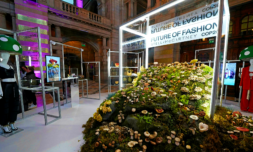Beautifully packaged in miniature perfume bottle decanters with marbled lids, they’re certainly the most stunning items on Pleasing’s menu.
But the products themselves have hardly caused a stir in the beauty and fashion press, which has subsequently exploded with dialogue about Styles’ latest career move. As is often the case with Harry Styles, the focus has turned hastily toward gender, more specifically masculinity and its place in the modern world.
Paper magazine touted Pleasing as the latest move in Styles’ ‘modus operandi of blurring the lines of traditional masculine and feminine concepts’. While the Daily Mail and Metro fixated on the ‘dresses and heels’ he donned in the Dazed shoot.
It’s certainly no bad thing that Harry Styles has ignited open and wide-ranging debate about binaries and norms.
His devil-may-care attitude toward gender has even garnered support from the most unlikely of places, with Youtuber Logan Paul defending Styles’ Vogue cover and denouncing ‘toxic masculinity’ last November.
However, be it positive or negative, the frenzy triggered whenever Styles wears something slightly beyond the realm of ‘manly man’ – be that a perfectly manicured finger, a ballerina tutu, or (as was the case last month) a Dorothy of Oz costume – demonstrates our stubbornness to change, our inability to accept the gender fluidity we so celebrate in Styles himself.
Fixation on Harry as a man who ‘can truly do no wrong’ because he refuses to carry himself as a ‘traditional’ guy, brings us back to the idea that what you wear really matters.
Of course, clothes are integral to our sense of self-expression, but isn’t the notion that a glittery boot signals ‘gay’ or a plaid shirt signals ‘lesbian’ a little outdated?
For decades, queer people have been reduced to their bodies and the clothes upon them. Viewed in purely aesthetic terms, they have long been denied social agency, justifying their marginalisation and sexual exploitation by a heteronormative elite.
Obsession with Harry Styles’ ‘queer’ signals continues this narrative, that one’s creative output is entirely hinged on the nature of their sexual or biological identity.
With the rounds of praise regularly flung toward Styles, also comes the criticism. Besides the purely homophobic defenders of ‘real masculinity’ there are those who view his dress-wearing and makeup-designing as a form of queer bating.
Others see his success as a corollary of his white, cis status. Actor Billy Porter recently called out Harry’s style, claiming that he himself had ‘changed the whole game’ of gender non-confirming fashion, while all Styles had to do was ‘be white and straight’.
Unpicking the latent racism and sexism of celebrity commentary is certainly no futile task, but when will men dressing in skirts and selling makeup be something we accept as the norm, celebrating only because the skirt is gorgeous, or the makeup fantastic?
Sensationalising ‘Pleasing’ because it marks another rung in Harry Styles’ ladder to queer heaven is starting to grate on me. It further alienates femininity as something bizarre, even gauche. Unless, of course, it pertains to a woman, where it can be neatly controlled and ideated by a misogynistic media.
I’m sure Harry’s fans and skincare fanatics alike will be digging deep into their proverbial pockets for Pleasing’s launch. I can’t say the packaging hasn’t already piqued my interest.
But the success (or failure) of the brand should depend on the quality of its products, the nature of its customer care, and the creativity of its marketing brief. Not because a man made it – or because he sometimes wears a dress.


















